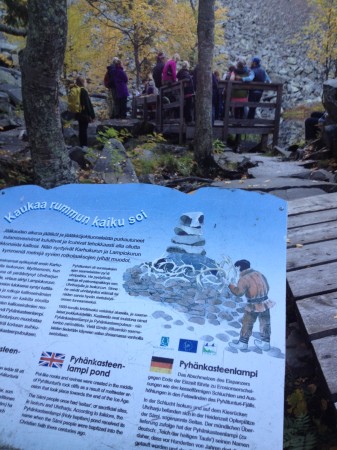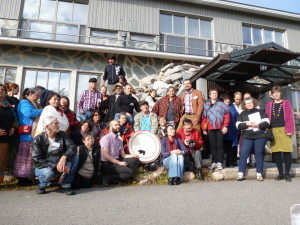
Caption: Presentation of the Conference Statement by the indigenous participants. Photo: Bas Verschuuren.
By Leena Heinämäki, Thora Herrmann and Bas Verschuuren on behalf of the conference co-organizers
In September 2013, a group of nearly 80 participants from 12 different countries and 7 different Indigenous Peoples developed the “Conference Statement and Recommendations on: Recognition and Safeguarding of the Sacred Sites of Indigenous Peoples in Northern and Arctic Regions” available here in English, Russian, French and Spanish. Media may also make use of the “Press Release” here.
The people involved were sacred site guardians of indigenous communities, indigenous peoples’ organizations, scientists, policy makers and members of civil society organisations. They gathered together in the capital of Finnish Lapland, Rovaniemi, as well as in Pyhätunturi, a sacred mountain of the ancient Forest Saami people. The first international, multidisciplinary conference on Arctic sacred sites drew participants from six Arctic countries, as far away as Yakutia, Eastern Siberia, Canada and Alaska. For many of the indigenous representatives it was their very first time ever in Finland.
If one trims the branches and the crown of a tree, the tree regenerates and grows better, but if one cuts the roots of a tree… the tree dies. That’s how it is for our identity and our culture… – An Innu spiritual guide at Pyhätunturi and Rovaniemi 2013.
This conference statement is one of the many outcomes of the conference that can be used strategically to increase recognition of sacred sites in policy, management and development. The Statement calls for improved recognition, legal protection and management of the sacred sites and sanctuaries of indigenous peoples in the Arctic region. In the following ways:
-

The conference participants visit an ancient “seita” or sacred sacrificial site of the Forest Saamii named the Pyhänkasteenlampi Pond. Pyhänkasteenlampi meens pool for baptism and was the name assigned to the ancient ‘seiti” when Christianity came to the area of Pyhätunturi. Today the site is well protected from visitor impact and interpretive signage has been placed by Metsähallitus who manage the national park and provide guided tours. Photo: Bas Verschuuren.
It reaffirms the need for respect for indigenous peoples’ right to self-determination and their view that any measure for the protection of indigenous peoples’ sacred sites must be seen under self-determination and the principle of free, prior and informed consent.
- It acknowledges the urgent need to address growing threats to sacred naturals sites such as: climate change, industrial development, extractive industries such as mining, forestry, hydro-electrics, oil and gas, unsustainable tourism, military operations, low level flying, State dominated educational curricula, religious imposition and vandalism.
- It includes a variety of recommendations to State governments, general public, civil society and media as well as environmental and conservation organizations, religious associations and faith groups, business, corporations and academia, researchers and the education sector.
The conference statement will be presented at major forthcoming events, such as the 2014 IUCN World Parks Congress in Australia a landmark global forum on protected areas held every ten years and at the Thirteenth Session of the United Nations Permanent Forum on Indigenous Issues (May 2014). In addition it will be shared widely among indigenous peoples organisations, environmental and development NGOs, policy-making bodies such as the Arctic Council and the wider international community. It will also be included in the forthcoming book on Arctic Sacred Sites (scheduled for 2015).
The aim of the event was to amplify the voices of Sacred Sites custodians and enhance a dialogue between communities, scientists and decision-makers to assure that social, cultural, religious and spiritual – in addition to biological diversity – are taken into account in law, policy and field action related to sustainable development in the North. – Ms.Thora Merman, Professor.at the Université de Montréal (Canada) one of the co-organisers of the conference.
Over three days, participants spoke about issues related to sacred sites in the entire circumpolar area. Many speakers underlined that the safeguarding of sacred sites requires universal involvement. The multidisciplinary approach of the conference established themes dealing with multiple meanings of the sacred sites, including questions related to identity, ethnicity and transmission of the culture, education, arts and economics. Sacred sites were discussed as a part of the cultural heritage of indigenous peoples, including themes around mythology, spiritually relevant practices and the role of sacred sites for indigenous cosmologies.
The Conference also succeeded to create a platform to establish a holistic, multidisciplinary approach to tackle multiple issues of the Sacred Sites in the North, including:
- the development of a participatory educational research project to advance the transmission of spiritually relevant culturally embedded knowledge and practices related to sacred sites to younger generation,
- discussing sacred sites as an important means for the conservation of biological and cultural diversity in relation to, ecosystem conservation and socio-ecological resilience,
- Publishing a book that includes 23 chapters with a high quality articles written by the participants of the Conference is currently being developed,
- raising broader public awareness of the challenges and threats faced by sacred sites and their custodians.
The legal recognition of sacred sites linked in well with the objective of the Conference to develop strategies towards more effective protection and management of the Sacred Sites in Northern and Arctic region that are based on indigenous peoples’ own practices and customary laws. – Ms. Leena Heinämäki PhD. Research Fellow with the Arctic Center and also- organiser to and host of the conference.
The media, including regional press of Lapland, Nunavut’s territorial newspaper (Canada), and the Finnish national television showed covered this warm-spirited event that emphasized the mutual partnership and respect between participants with different backgrounds.
The conference was co-organized by the Northern Institute for Environmental and Minority Law (NIEM) at the Arctic Centre of the University of Lapland, the Université de Montréal(Canada), and the University of the Arctic /Thematic Network on Arctic Law, and hosted a range of wonderful Key speakers from around the world and a variety of disciplines and backgrounds.
For more information, please visit the conference website and for additional information on sacred natural sites including conference statements and useful resources from other parts of the world can be found at the Sacred Natural Sites Initiative website









One Response
Thank you to the organizers and participants for their work in forging a path toward an improved future.